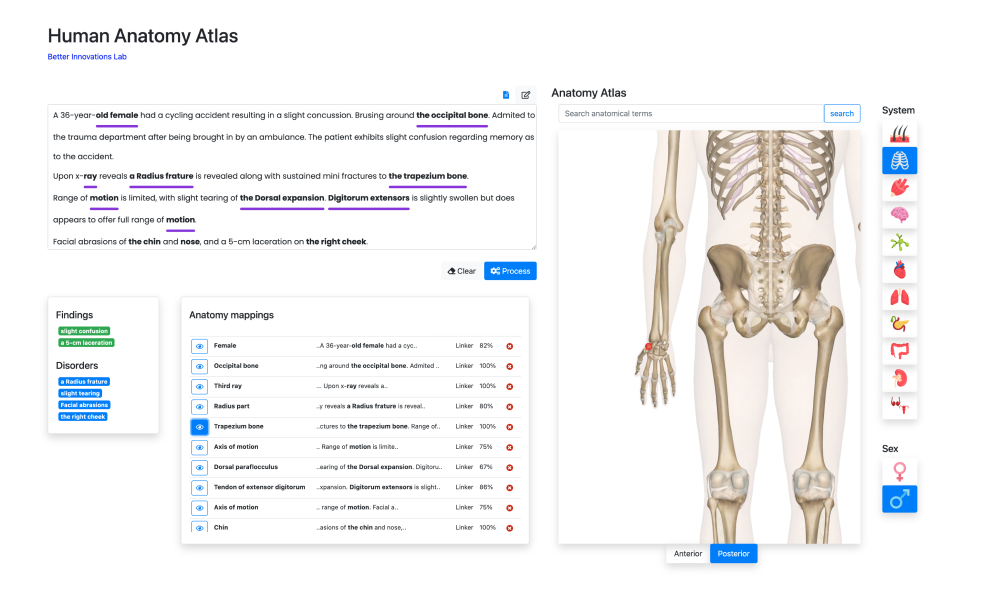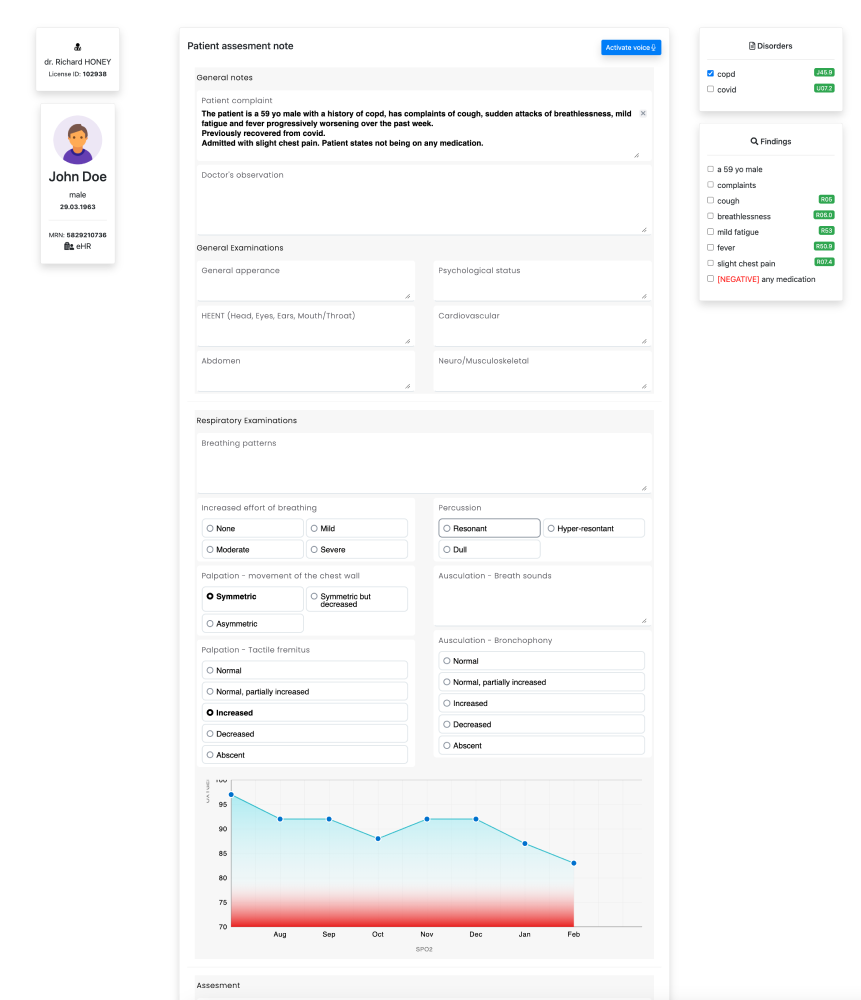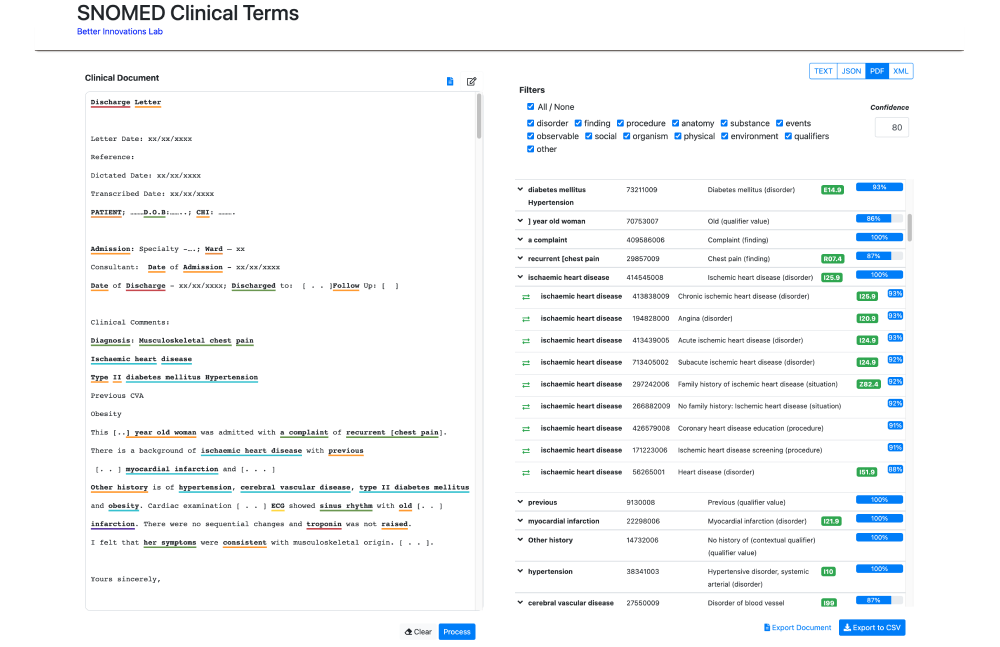openEHR
SNOMED concept linker makes the retrieval of relevant information simple and efficient
As a data-first focused company, Better's solutions revolve around bringing structure to the data. SNOMED concept linker takes any form of a free-text clinical document as input and returns a list of identified clinical concepts.
We talked to Robert Tovornik, a data scientist at Better Innovation Lab, who was in the team that developed the SNOMED concept linking technology. As he explained, "clinical concepts, such as illnesses, disorders, medical procedures, and other clinical entities, are all identifiable by SNOMED clinical terms. Forming a link between terms and concepts, allowing for a computer to understand the document's content, it is a powerful tool for rapid data extraction, matching millions of concepts in a near instant".
Robert was also part of the team that took part in a research project DisTEMIST (DISease TExt Mining Shared Task) about large-scale biomedical semantic indexing and question answering, where they ranked second in the disease linking to SNOMED Clinical Terms category. Read more about this groundbreaking technology and about what the Better Innovation Lab really does in the interview below.
What do you do in the Innovation lab? What have been your latest achievements and innovations?
The role of the Better Innovation Lab is to track new and upcoming technologies, study them to the point of understanding and when needed, find ways to utilise them as a part of our products. Since we have learned that the best way to understand a technology is through the application, we develop and test different potential use cases as proofs-of-concept, on the side, as part of the innovation process. By doing so, even the less imaginable ideas become tangible and more easily presentable. Then through an introduction to a broader audience, we attempt to spark further interest in those who might benefit from the technology the most.

As a data-first focused company, our solutions revolve around bringing structure to the data. The data structure is, to some degree, easily imposed with new applications through system design. However, the healthcare domain holds vast amounts of its data, by some estimates around 80%, in unstructured free text format, represented as clinical notes, medical reports, and other. Finding relevant information in these types of documents can be an extremely time-consuming task, but utilising concealed information is viewed as one of the most fundamental challenges in transforming medical care, with the goal to improve patient outcomes. Therefore, most of our recent attention has been focused on Natural Language Processing (NLP), a field that offers established techniques to give insight into document data. Combining NLP techniques with SNOMED Clinical terms, produced our latest innovation – the “SNOMED concept linker”.
What is SNOMED concept linking and what kind of technology does it use?
SNOMED concept linking is a recently developed data processing technique. It takes any form of a free-text clinical document as input and returns a list of identified clinical concepts. Clinical concepts, such as illnesses, disorders, medical procedures, and other clinical entities, are all identifiable by SNOMED clinical terms. In pursuit of Intelligent document processing, Text Analytics and Semantic Search, SNOMED concept linking is a basis for many new use cases aimed at SmartEHR. The technology behind it is rather complex, but the beauty of it lies in the processing speed and the quality of the retrieved data. Forming a link between terms and concepts, allowing for a computer to understand the document's content, we get a powerful tool for rapid data extraction, matching millions of concepts in a near instant. A functional search tool that makes the retrieval of relevant information simple and efficient.

How can the solution be used in everyday life and what "problems" does it solve?
Think of the solution as one similar to Google search, but for the medical domain. When searching for patients with pulmonary diseases, it understands that you are interested in all those affected by, for example, pneumonia, COPD, tuberculosis or other, without having to specify them. When used as a document processing tool, applied via Text Analytics, it derives insight and brings data patterns to the foreground. When simply seeking context for the task at hand or searching for additional, hidden information, its Semantic Search capabilities can generate relevant search results or can be used to adapt the application interface to follow the user's workflow. By extracting care-related clinical concepts in real-time, the technology can guide patient care plans and clinical decisions, making the process interactive. The technology can also be used as a quality assurance tool, running in the background, validating treatment data, matching procedures with clinical coding in patient health records, and providing alerts where experts deem fit. Taking it a step further, there is potential to link the extracted data with more advanced data structures such as openEHR, bringing the list of possibilities to near limitless. Regardless of the application, principal goals remain the same: improving the flow of relevant information, improving communication, and speeding-up clinical processes to provide better patient care.
Who will benefit the most from this technology?
The main beneficiaries of clinical technology should, the same as with patient care, be the patients. By speeding up clinical processes, automating them, and reducing the time spent dealing with clinical systems and administration, we aim for clinicians to spend more time with the patient. By optimising the clinician workflow, we hope to improve patient care and, in the end, benefit the patient.

How will the clinicians' work be better with using this new technology?
The core advantage of SNOMED concept linking technology lies in its data structure and its consistency. Consistency throughout different care settings, systems, and even languages. It is not uncommon for doctors to switch departments, hospitals, and sometimes even states. Through a consistent representation of the data, the clinicians are familiar with the information provided and required by the systems. Thus, the clinicians spend less time adapting to the new systems and rather spend it on providing patient care. By offering clinicians interactive workflow, through the extraction of procedure-relevant data during the treatment, the clinicians’ work can become easier and more efficient.
 |
"We start with a problem. If new technology is needed, we take care of that; otherwise, we simply solve the problem." - Robert Tovornik, Data scientist |
How do you wish for it to be used in the future?
We aim to provide the SNOMED concept linking technology as a cloud service for anyone to use. Currently accessible to a limited audience, the service is available in production. The next steps involve integrating it into our company's existing products, providing an enriched electronic health record experience. Focused on helping patients by helping clinicians and healthcare organizations to provide better patient care, we believe it is time for the technology to be used in a way, where it aids and adjusts to the clinician's workflow instead of disrupting it.
.png)